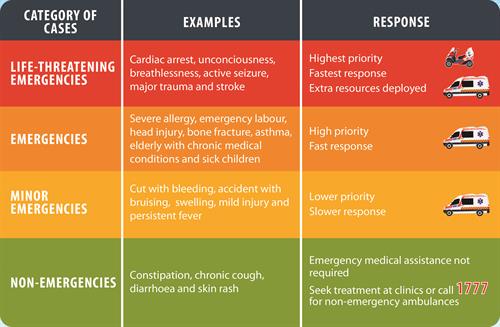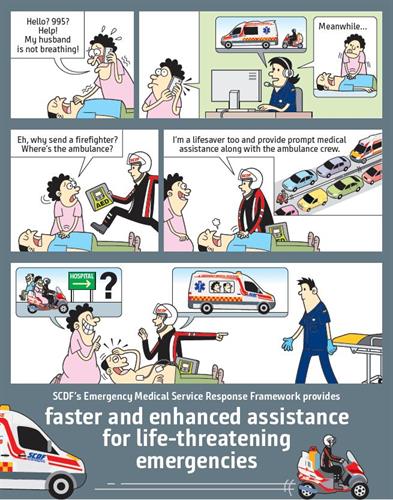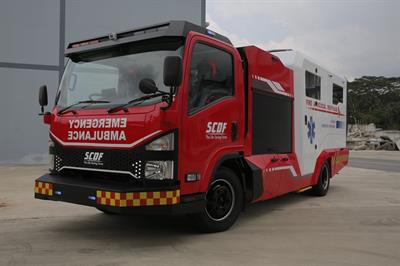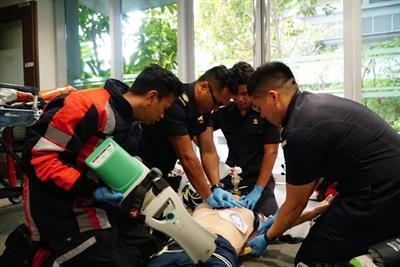The SCDF operates a 24-hour Emergency Medical Services (EMS), which is ready to respond to any medical emergency in Singapore. The EMS crew is well trained and equipped to handle a wide range of medical emergencies.
The SCDF responded to 256,837 EMS calls in 2022, or about 704 a day. In a life-threatening emergency, every second is invaluable. You can make a difference between life and death by knowing what an emergency is.
Examples of emergencies: cardiac arrest, seizures, breathlessness, loss of consciousness, excessive bleeding, major traumas and stroke.
Each year, about 10% of 995 calls are non-emergencies, an average of 50 calls a day. Every non-emergency call could delay SCDF's response to life-threatening emergencies, where every second counts.
Since April 2019, SCDF will not convey non-emergency cases to hospitals. Such cases will be advised to seek treatment from their family doctor or general practitioner at nearby clinics. For non-emergency cases who insist on going to a hospital, they will be advised to make their own arrangements or call 1777 for a non-emergency ambulance.
From 2023 onwards, SCDF’s 995 Operations Centre will assess emergency call and send out ambulances only when they are deemed to be actual emergencies. This will ensure that our EMS resources are optimised for emergencies only, as committing emergency resources to non-emergency cases will deprive those in need.
Examples of non-emergencies: toothaches, diarrhoea, coughs, headaches, slight burns or scalds, constipation, or medical check-ups.
About SMS 70995
The SCDF has introduced the Emergency Short Messaging Service (SMS) function as part of its overall 995 emergency call taking capability. The number designated for SCDF’s Emergency SMS is 70995. This service is specially catered for
people who are deaf, hard-of-hearing and speech impairment (DHS). Members of the DHS community can use a mobile phone to send an SMS to SCDF during emergencies such as a fire and/ or a medical condition requiring an SCDF emergency ambulance to convey
them immediately to hospital.
How do I use the service?
Send a brief SMS message to 70995 containing information on:
- the nature of emergency (e.g. what has happened or is happening);
- the location where it is happening (address or prominent landmark); and
- the type of help required (fire / ambulance).
Contacting SCDF through SMS
When sending an emergency SMS to SCDF, DHS members are required to text the following information in their message:
- Which Service is Required (Fire Engine or Ambulance);
- Address/ Incident Location (Be descriptive, include landmarks); and
- Nature of emergency (Fire, someone is trapped in the house, experiencing chest pains).
A typical emergency SMS message would be as follows:
- For Fire:-
Fire Engine. Blk 889 Tampines St 81 #[Unit Number.] or Postal Code, #[Unit Number]. My neighbour’s room is on fire.
- For Ambulance:-
Ambulance. Blk 889 Tampines St 81, #[Unit Number] or Postal Code, #[Unit Number]. My mother has fainted.
When an emergency SMS is received from a registered DHS user, SCDF will send out an auto-reply SMS to acknowledge receipt of the message, and that SCDF officers are attending to the SMS message. A follow-up SMS will also be sent to inform that SCDF resource(s) are on the way.
Note: There are no additional charges apart from the normal Telco charges applicable to SMS.
Do's and Don'ts
- Indicate which service you require and why (eg. Police, Ambulance or Fire engine)
- Try to be as detailed as possible when providing your location (eg. street name, block number, unit number, name of establishment, etc.)
- Include a brief description of what had happened.
- Avoid ambiguous SMS abbreviations (eg. ‘I w W8 4 Pol b4 e bus stopl8r’ which means to say ‘I will wait for Police before the bus stop later’).
NOTE: Unless you have a disability to speak, you are highly encouraged to call 995 to speak to our operators.




